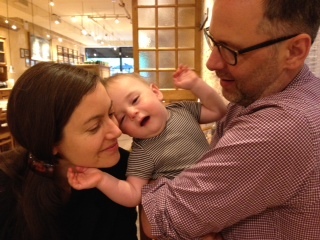
The nature of the early attachment to our parents or primary caretakers influences (to a major degree) our relationships for the rest of our lives.
John Bowlby (1907-1990), the first attachment theorist, concluded that these early emotional bonds affect us from "the cradle to the grave." He observed that the cries of an infant when separated from a parent or caretaker is an adaptive response to assure his survival. The child feels loved when a parent (or caretaker) is accessible, attentive and reliable, and this in turn, leads to feelings of security and confidence that allow him to explore his environment. Failure to receive good-enough physical or emotional nurturing leads to (feelings of) anxiety, or in more extreme cases, despair and depression.
As we mature, we form bonds outside the family. Ideally the circle of connections increases to include teachers, peers, girl or boy scout troops and/or fellow team mates.
The adage, "Don't put all your eggs in one basket" is a useful metaphor to keep in mind. Often, people with affiliations (beyond attachments to fellow humans) to include a discipline, like arts or sciences, fare better than those who rely exclusively on interpersonal relationships. Outside interests render us less vulnerable to our less-than-perfect fellow humans who at times fall short of our expectations.
Mr. D. failed to receive good-enough nurturing early in life and never felt loved or accepted by his wife or children. When his dog died, he experienced a severe depression and had to be hospitalized.
By contrast, Ms. W. was able to transform her feelings of abuse (at work) to an interest in studying law. Desire to learn the legal aspects of work place behavior connected her to the library and to other people in similar situations.
Jonathan Lear's classic 1990 book Love and its Place in Nature, a philosophical interpretation of Freudian analysis, expands Freud's libido theory to positive connections beyond intimate relationships. Love, a basic force in nature, underlies the (infinite possible) positive affiliations to our world.
Our connections to the world are in a state of flux throughout our lifetime. We attach and detach to people, places and things as we evolve.
Mr. I. married twice and lost his wives to illness. In middle age, he decided he preferred a variety of friends to forming another marital bond.
Flexibility of our attachments and connections leads to physical and emotional health. By contrast, rigidity leaves us vulnerable.
When forced to retire early, Mr. F. became very depressed. He hadn't realized the extent to which he had relied on his job to fill his life.
Today many of us bond with technology. Witness the ubiquitous presence of the laptop and iPad. How this reliance alters the nature of our relationships to each other and our world is complex, and at present, to a large degree, unanswered.
Conclusion: Attachments and connections change throughout our lives. The quality of flexibility helps us adjust to our evolving selves and the world.
Need help? In the U.S., call 1-800-273-8255 for the National Suicide Prevention Lifeline.
